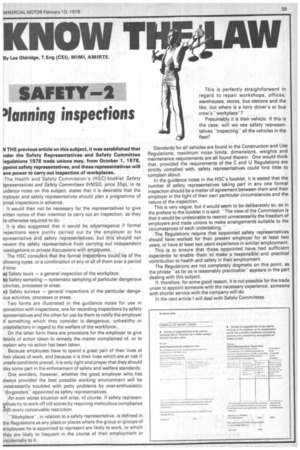SAFIETY-2 'tanning inspections
Page 41

If you've noticed an error in this article please click here to report it so we can fix it.
NI THE previous article on this subject, it was established that nder the Safety Representatives and Safety Committee legulations 1978 trade unions may, from October 1, 1978, ppoint safety representatives, and these representatives will ave power to carry out inspection of workplaces.
The Health and Safety Commission's (HSC) booklet Safety 'epresentatives and Safety Committees (HMSO, price 35p), in its uidance notes on this subject, states that it is desirable that the mployer and safety representatives should plan a programme of )rmal inspections in advance.
It would then not be necessary for the representatives to give iritten notice of their intention to carry out an inspection, as they re otherwise required to do.
It is also suggested that it would be adyantageous if formal -ispections were jointly carried out by the employer or his epresentative and safety representatives, but this should not irevent the safety representative from carrying out independent westigations or private discussions with employees.
The HSC considers that the formal inspections could be of the ollowing types, or a combination of any or all of them over a period if time: a) Safety tours — a general inspection of the workplace.
b) Safety sampling — systematic sampling of particular dangerous ictivities, processes or areas.
b) Safety surveys — general inspections of the particular dangeous activities, processes or areas.
Two forms are illustrated in the guidance notes for use in onnection with inspections, one for recording inspections by safety :epresentatives and the other for use by them to notify the employer )f something which they consider is dangerous, unhealthy or insatisfactory in regard to the welfare of the workforce..
On the latter form there are provisions for the employer to give Jetails of action taken to remedy the matter complained of, or to axplain why no action has been taken.
Because employees have to spend a great part of their lives at :heir places of work, and because it is their lives which are at risk if Ansafe conditions prevail, it is only right and proper that they should play some part in the enforcement of safety and welfare standards.
One wonders, however, whether the good employer who has always provided the best possible working environment will be Jrinecessarily troubled with petty problems by over-enthusiastic -do-gooders" appointed as safety representatives.
An even worse situation will arise, of course, if safety representatives try to work off old scores by requiring meticulous compliance voth every conceivable restriction.
"Workplace", in relation to a safety representative, is defined in the Regulations as any place or places where the group or groups of employees he is appointed to represent are likely to work, or which they are likely to frequent in the course of their employment or incidentally to it. Standards for all vehicles are found in the Construction and Use Regulations: maximum noise limits, dimensions, weights and maintenance requirements are all found therein. One would think that, provided the requirements of the C and U Regulations are strictly complied with, safety representatives could find little to complain about. In the guidance notes in the HSC's booklet, it is stated that the number of safety representatives taking part in any one formal inspection should be a matter of agreement between them and their employer in the light of their own particular circumstances and the nature of the inspection. This is very vague, but it would seem to be deliberately so, as in the preface to the booklet it is said: "The view of the Commission is that it would be undesirable to restrict unnecessarily the freedom of employers and trade unions to make arrangements suitable to the circumstances of each undertaking."
The Regulations require that appointed safety representatives should have worked for their present employer for at least two years, or have at least two years experience in similar employment. This is to ensure that those appointed have had sufficient experience to enable them to make a responsible and practical contribution to health and safety in their employment.
The Regulations are not completely dogmatic on this point, as the phrase "as far as is reasonably practicable" appears in the part dealing with this subject. If, therefore, for some good reason, it is not possible for the trade union to appoint someone with the necessary experience, someone with shorter service with the company will do.
In the next article I will deal with Safety Committees.












































































































